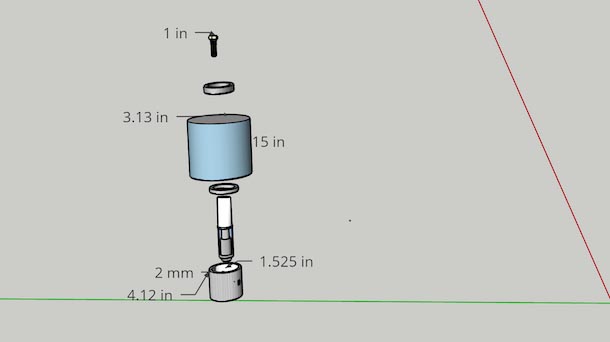
3D model screenshot for sink handle with sanitizing UVC light built-in. IMAGE: K’ASHE MCKINNEY
Engineering capstone design projects adjusted to battle pandemic
4/15/2020
By Jamie Oberdick
UNIVERSITY PARK, Pa. — When two teams of students in a Penn State biomedical engineering capstone design course received their projects at the beginning of the spring semester, little did they know that their efforts would have relevance to a pandemic.
The students in BME 450W: Biomedical Senior Design work on projects offered by a variety of industry and academic sponsors. The course, taught by Spencer Szczesny, assistant professor of biomedical engineering, moved online due to COVID-19 in mid-March.
One project involves pandemic prevention by designing a self-sanitizing sink via built-in UVC light, a type of light that destroys bacteria and viruses. The other project involves a low-cost electronic stethoscope sent to households in areas with low health care infrastructure or in times of pandemic-induced social distancing.
The self-sanitizing sink team is sponsored by Penn State’s School of Engineering Design, Technology, and Professional Programs (SEDTAPP). The students were tasked with developing a solution that could either help prevent a future pandemic from happening or contain the number affected during an active pandemic.
The sink they developed may solve a problem that arises during hand washing — a significant way to curtail viral infections, such as the current COVID-19 pandemic, according to the Centers for Disease Control.
“Suppose I go to wash my hands and I have viral pathogens on my hands,” said K’Ashe McKinney, senior in biomedical engineering and project team member. “I would turn on the faucet, wash my hands as usual and then turn it off. But the viral pathogens would be on the sink handle that I touched before I started handwashing and then touched after I washed my hands.”
The solution her capstone design team came up with, McKinney said, is a sink that uses UVC light to self-sanitize. The team chose UVC light because it kills both viruses and bacteria, so it would have broad application. In their design, the sink would be one with two handles for cold and hot water, and the battery-powered lights would be inside quartz sink handles. The UVC lights will always be on as they are powered by electricity from a wall outlet and rechargeable AA batteries as a backup in case of a power outage.
“UVC lights do not take a long time to kill viruses, and quartz works well because the light can transmit throughout the entire handle,” McKinney said.
As for the future of the device, McKinney said that they are limited as far as prototype building due to no in-person learning at Penn State. They are currently using software to simulate the device.
“Our goal right now is just to expand on the concept and do further simulations with software programs like COMSOL to see how far we can go,” McKinney said. “You never know what may happen in the future. Somebody might say, ‘Hey this is a really cool idea,’ and it’s used everywhere.”
Along with McKinney, other team members on this project include Alexander So, Michelle Carney, Emma Daly, Pranay Gudur and Molly Smith.
The other project originally was intended for areas with limited health care infrastructure: a low-cost, mass-produced electronic stethoscope that can be sent to households for use.
“Our project began actually before coronavirus was big in the news, however following the coronavirus and the shortcomings of the global response helped tailor our solution to preventing pandemic,” said Steven Petrone, junior in computer engineering.
The stethoscope can be plugged into any computer, and a web app guides the user through operation, using it to hear sounds of the heart and lungs. Once COVID-19 hit in earnest, the team realized their remote stethoscope would work well for pandemics and the required social distancing.
“The signal from the stethoscope can either be analyzed by an algorithm or medical professional to determine if a patient has a respiratory infection,” Petrone said. “Ideally detection can occur well before noticeable symptoms manifest. Our hope is that this could lead to much earlier detection for faster quarantining of patients, especially when a virus-specific test is not yet available.”
Other student members of the team working on the stethoscope include Alicia Kasson, Hunter Johnstone, Ben Hantranft and Gareth Howe. The project is also sponsored by SEDTAPP.
For Petrone, this project has given him great personal satisfaction because he feels the innovative stethoscope could potentially help fight future pandemics.
“What I like most about the project is applying my computer engineering background to a field that I didn't know I could be useful in,” Petrone said. “And we are potentially creating something that can have a huge impact to the world’s health.”



